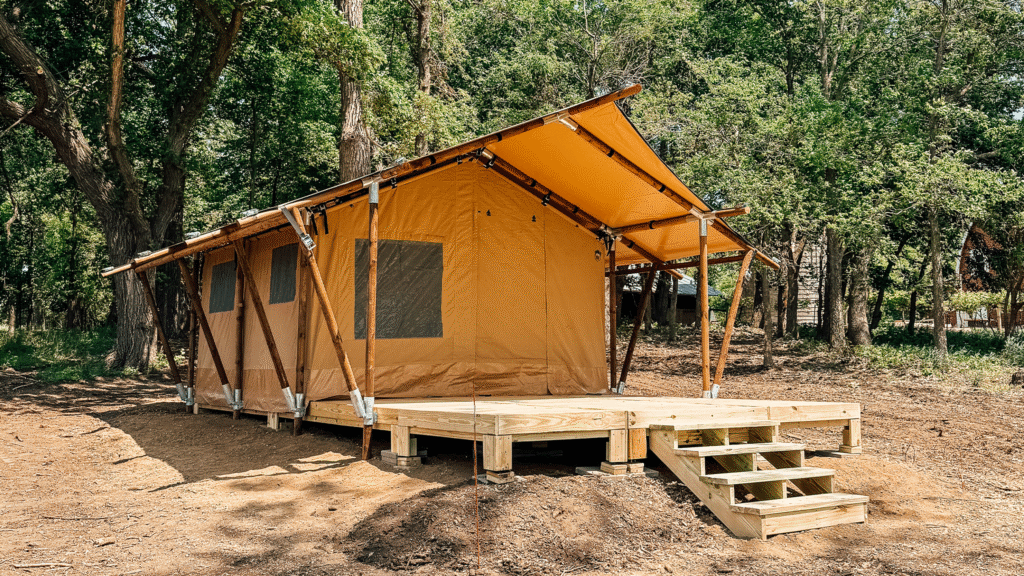
What was once seen as a niche activity has become a mainstream travel preference. Camping and its more luxurious cousin, glamping, are no longer just hobbies—they’re full-fledged industries. As more people seek meaningful, nature-based experiences, the outdoor hospitality sector is booming. Behind this growth are evolving consumer behaviors, advances in mobile-friendly infrastructure, and a desire for balance between adventure and comfort.
For those in the business—or considering it—it pays to understand what’s driving this shift.
Travelers today want more than hotel rooms—they want experiences. Whether it’s waking up to birdsong in a forest or sipping coffee on a deck overlooking a mountain valley, these moments are the currency of modern travel.
Camping delivers the immersion, and glamping adds the amenities. The sweet spot lies in creating authentic yet comfortable experiences, where infrastructure supports nature, not replaces it.
Platforms, decks, and modular systems are vital here—they provide structure without sacrificing that off-the-grid feeling.
The effects of 2020 reshaped how people vacation. Crowded tourist spots lost appeal, while remote, self-contained travel surged. RV sales skyrocketed. Tent and outdoor gear sales followed. Nature offered safety, solitude, and a sense of grounding.
That momentum hasn’t slowed. In fact, travelers have developed long-term appreciation for the slower, simpler style of outdoor living—especially when paired with clean bathrooms, nice bedding, and a solid wooden deck underfoot.
Younger generations aren’t just tech-savvy—they’re experience hungry and eco-conscious. Millennials and Gen Z travelers value authenticity, sustainability, and social media-worthy destinations. Camping checks all those boxes, especially when the sites are thoughtfully designed and shareable.
Decking, for instance, elevates the experience (literally and figuratively), offering better lighting, seating options, and staging for that perfect sunrise photo or evening lantern glow.
Another reason for the industry’s rise? A broader demographic now sees camping and glamping as viable. Families with young kids, older travelers, and those who previously saw camping as “too rugged” are now drawn in by more accessible amenities.
Infrastructure like raised decks, modular ramps, and walkways make sites more navigable. With thoughtful planning, outdoor destinations can be both rustic and inclusive.
Thanks to modular construction, it’s easier than ever to launch and scale outdoor accommodation. You don’t need to break ground or pour concrete to offer a solid platform or patio. Modular decking solutions make it possible to:
This kind of flexibility is fueling creative business models and making camping more adaptable than ever.
As camping diversifies, we’re seeing specialized trends emerge:
The common thread? Each niche depends on intentional infrastructure that enhances the outdoor experience. And much of that starts with thoughtful decking that provides structure, comfort, and versatility.
With insulated glamping tents, fire pits, and weather-resistant decks, many sites are now open beyond the typical summer season. Fall foliage weekends, winter stargazing, and spring birdwatching are adding new revenue windows for campground owners.
Modular decks built with pressure-treated wood and elevated off the ground stay usable and safe year-round, with minimal maintenance.
Finally, we can’t overlook the power of visuals. Instagram and TikTok are unofficial booking engines for outdoor travel. A well-designed site with wooden decks, string lights, and stylish tents becomes its own marketing tool. The more photogenic and shareable a site is, the more organic interest it generates.
That’s why form matters just as much as function—details like railings, stairs, and deck stain colors help tell a story guests want to share.
Camping and glamping aren’t just enjoying a moment—they’re evolving into a lifestyle choice for millions. With smart infrastructure, modular flexibility, and an eye on design, campground and outdoor business owners can ride this wave successfully. Whether rustic or refined, today’s outdoor spaces must be both practical and emotionally resonant.
And it often starts with a well built platform underfoot.
Combine all three to get the lowest price per square foot and 10% off every add-on.